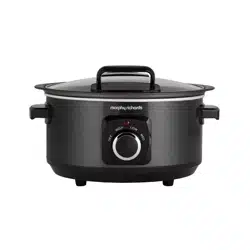Loading ...
Loading ...
Loading ...

7
• M
ost foods are suited to slow cooking methods,
however there are a few guidelines that need to
b
e followed.
• Ensure all frozen ingredients are thoroughly
d
efrosted prior to cooking.
• Cut root vegetables into small, even pieces, as
they take longer to cook than meat. They can be
g
ently sauteed for 2-3 minutes before slow
c
ooking. Ensure that root vegetables are always
placed at the bottom of the Cooking Pot
(3) and
all ingredients are immersed in the cooking liquid.
• Trim all excess fat from meat before cooking, as
the slow cooking method does not allow fat to
evaporate.
• If adapting an existing recipe from conventional
cooking, you may need to reduce the amount of
liquid used. Liquid will not evaporate from your
Slow Cooker to the same extent as conventional
cooking.
• Never leave uncooked food at room temperature
in your Slow Cooker.
• Uncooked kidney beans must be soaked
overnight and boiled for at least 10 minutes to
remove toxins before use in a Slow Cooker.
• Insert a meat thermometer into joints of ham or
whole chicken to ensure they are cooked to the
desired temperature.
• Do not use your Slow Cooker to reheat food.
• The Slow Cooker must be at least half full for best
results.
• Slow cooking retains moisture. If you wish to
reduce liquid, remove the Lid after cooking and
turn the control to High. Reduce the moisture by
simmering for 30 to 45 minutes.
• If cooking soups, leave 5 cm gap from the rim of
the Cooking Pot (3) and the food surface to allow
for simmering.
• Removing the Hinged Glass Lid (2) will allow heat
to escape, reducing the efficiency of your Slow
Cooker and increasing the cooking time. If you
remove the Lid to stir or add ingredients, you will
need to allow 10-15 minutes extra cooking time
for each time you remove it.
• Many things can affect how quickly a recipe will
cook, including water and fat content, initial
temperature of the food and the size of the food.
Check food is properly cooked before serving.
• M
any recipes will take several hours to cook. If
you don’t have time to prepare food in the
morning, prepare it the night before, storing the
f
ood in a covered container in the fridge. Transfer
the food to the Cooking Pot and add boiling
l
iquid/stock. In most of the recipes in this book,
the meat ingredients are browned first to improve
their appearance and flavour.
• If you are short on preparation time and would
prefer to skip the searing stage, simply add your
m
eat and other ingredients into your Slow Cooker
and cover with boiling liquid/stock. You will need
to increase the recipe cooking time as follows:
High setting +1 hour, Medium setting +1-2 hours,
Low Setting +2-3 hours.
• Most meat and vegetable recipes require 8-10
hours on Low, 6-8 hours on Medium and 4-6
hours on High. Cook chicken dishes for the
minimum time for the setting.
• Some ingredients are not suitable for slow
cooking. Pasta, seafood, milk and cream should
be added towards the end of the cooking time.
• Pieces of food cut into small pieces will cook
quicker. A degree of ‘trial and error’ will be
required to fully optimise the potential of your
Slow Cooker.
• All food should be covered with a liquid, gravy or
sauce. In a separate pan or jug, prepare your
liquid, gravy or sauce and completely cover the
food in the Cooking Pot (3).
• When cooking joints of meat, ham, poultry etc,
the size and shape of the joint is important. Try to
keep the joint in the lower 2/3 of the pot. If
necessary, cut into two pieces. Joint weight
should be kept within the maximum limit of
1kg for 3.5L Slow Cooker and 2kg for 6.5L
Slow Cooker.
• For ham and brisket fill with hot water to just
cover the joint. For beef, pork or poultry cover to
1/3 depth.
Slow Cooking Tips
Foods For Slow Cooking
SC460020 MUK Rev 1.qxp_Layout 1 27/03/2019 15:30 Page 7
Loading ...
Loading ...
Loading ...
